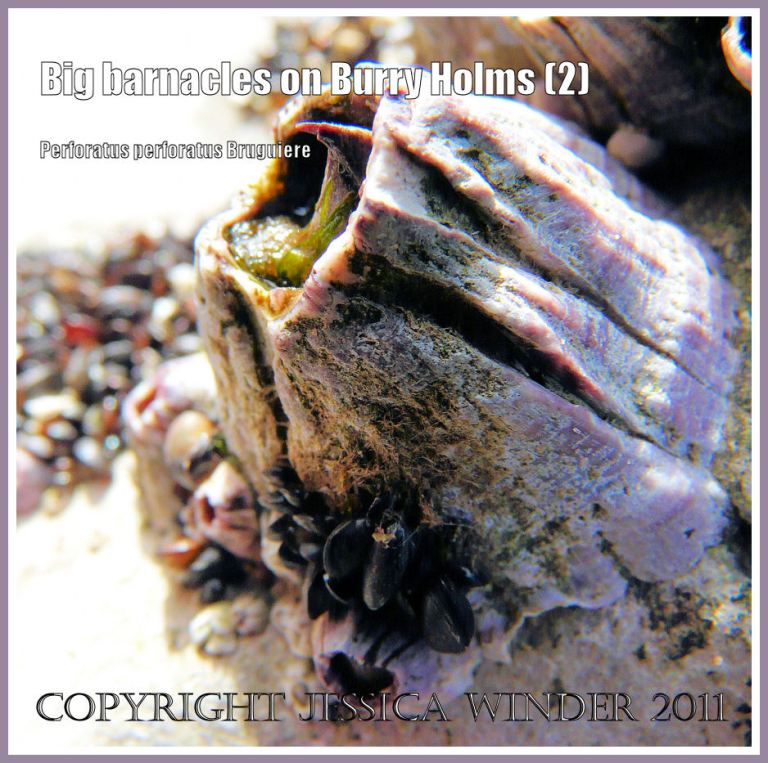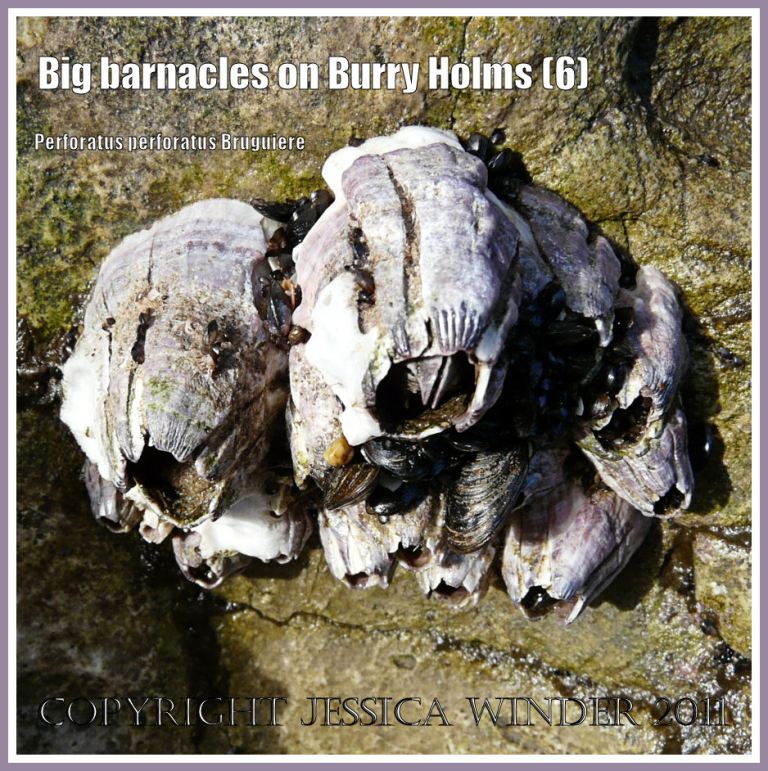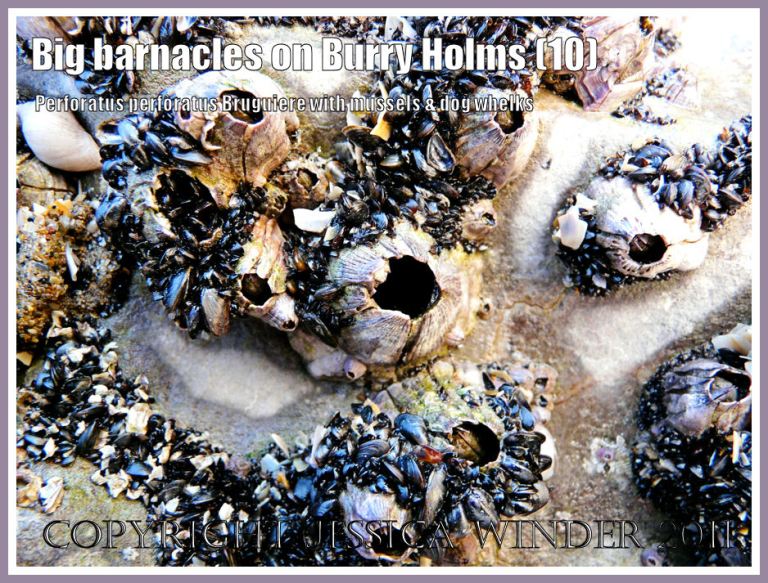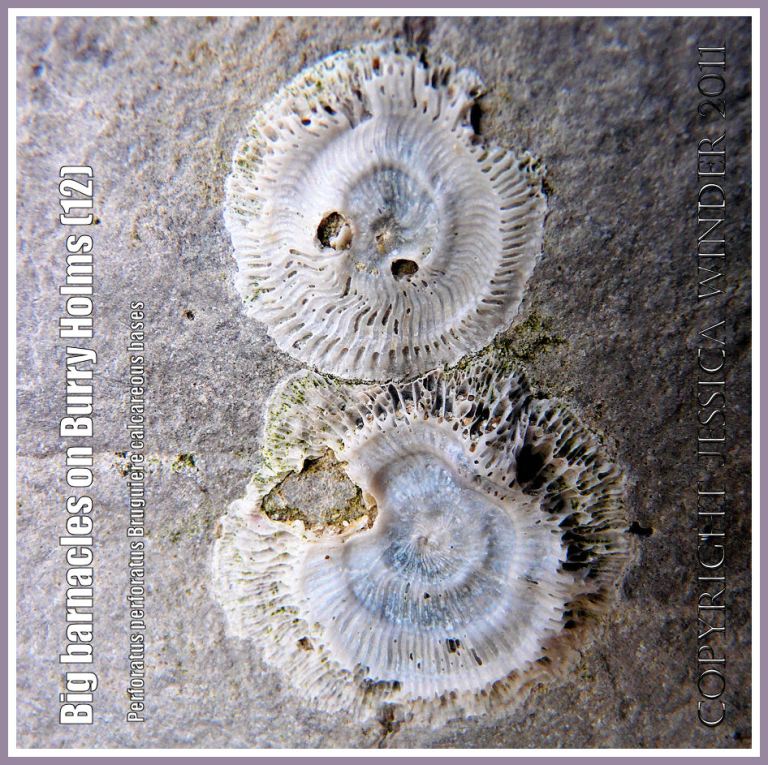In the early 1960’s there was a phenomenally severe winter which killed millions of seashore creatures around British coasts. One of the species that was wiped out at that time and considered to be locally extinct on the Gower shoreline was the large sessile or acorn barnacle called Perforatus (Balanus) perforatus Bruguiere. Recently, I discovered that I was mistaken in thinking this species had been exterminated here. What I had believed to be unoccupied shells were in fact inhabited.
P. perforatus is the largest of the common intertidal barnacles. It is easily recognised becaused of its size and shape. This barnacle has a regular cone-like shape with a small, more or less round, opening or operculum at the top. The shell is said to be upto 20 mm high with a diameter about 50 mm. The shell plates that comprise the cone are often a pink or purple colour.
Within the top opening are the four hinged plates (terga and scuta) by which the shell is sealed when the barnacle is out of water. The tergal plates have very characteristic beaks. These are well hidden deep inside the shell in young specimens where the edges of the operculum are unworn and the opening is small. However, as the barnacle ages, the sharp edges of the small opening get eroded so that the opening not only enlarges but the tergal and scutal plates appear relatively closer to the opening and the ‘beaks’ can protrude.
You can see this feature in several of the photographs including the close-up at the top of the post. You can also see that the erosion of the operculum edge exposes the (normally concealed) tubular perforations that extend vertically through the shell plates surrounding the animal.
The shell is attached to the rock by means of a round calcareous plate known as the basis. This can be several millimetres thick and is recognisable by its white colour which contrasts with the tinted shell plates. The basis remains cemented to the rock even when the rest of the barnacle shell becomes knocked off. You can see these white, roughly circular, structures on the rocks with their concentric growth lines, radiating lines, and lacey or honey-comb like perforations visible on the outer circumference. Shape varies quite a bit – especially where many barnacles have grown close together.
In some of the photographs in this post I have placed a ruler against the shell to give an idea of scale. The barnacles were large and seemed to achieve heights of about 30 mm if the basis is included in the measurement. Diameters seemed to be narrower than expected but this could be caused by the restricted space in which many specimens were growing.
P. perforatus usually occupies the lower half of the intertidal zone but it can extend into the sublittoral to a depth of 40 metres. The specimens in these photographs were exposed at low tide, attached to Carboniferous limestone boulders and the cliff of the island of Burry Holms at Rhossili. They were growing on vertical and overhanging rock surfaces, for upto a metre above the wet sand. They were mostly surrounded by small seed mussels, smaller species of acorn barnacle, and dog whelks predating on them.
Revision of a post first published 26 May 2010
COPYRIGHT JESSICA WINDER 2011
All Rights Reserved













Thank you for your great information!
LikeLike
Thank you, Katie. I’m glad you found the information useful. Thank you also for mentioning Jessica’s Nature Blog on your own blog Nature ID from the Central Coast of California at http://natureid.blogspot.com.
LikeLike
I am trying to determine whether or not a wheel I found in North Carolina, US is a barnacle or something else. Can you help me?
LikeLiked by 1 person
Thank you for sending the photos, Jodi. I have sent you a reply by e-mail.
LikeLike